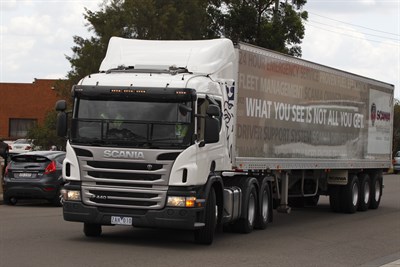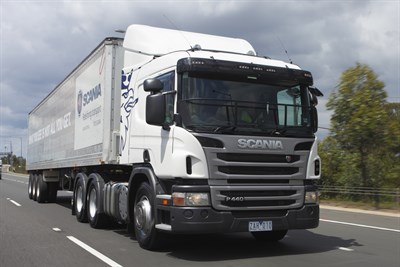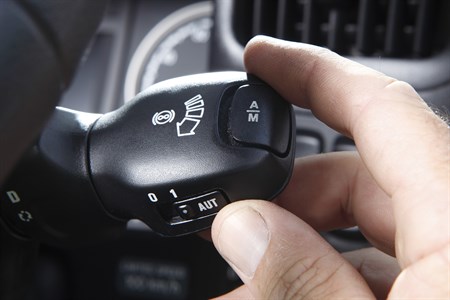Scania offers free fuel-efficiency training and the lessons can be applied widely, even for experienced drivers. Steve Skinner writes
Richard Hammond, the presenter from Top Gear, gives a disclaimer right at the outset of the Scania video on fuel-efficient driving.
“Let’s get something straight right away,” Hammond says.
“We’re not here to teach you how to drive, you’re professional drivers, we know you can already do that”.
What Hammond is there to do, he says, is give new Scania truck drivers some tips on how to save fuel and make the lives of the trucks and themselves a little easier in the process.
What not to do
A poor old rush-and-tear driver named ‘Alex’ is shown racing up to lights and intersections, madly changing gears and revving the guts out of the poor truck. He’s compared with another bloke who does everything smoothly and actually completes the test course quicker than Alex.
The video is part of the training package which comes at no extra cost with all new Scanias bought in Australia.
Operators and their drivers are offered the four-hour ‘peak efficiency program’ with their new truck, and from ATN’s experience of it, they’d be mad not to take up the offer.
Just don’t call it a ‘driver training program’.
“It’s about familiarising the person with how to use everything in the truck correctly to gain fuel efficiency,” Scania’s Master Driver Coach, Alan McDonald, says.
“Most drivers in big fleets will say they don’t care about fuel, because the company’s paying, but that’s not really the right attitude.”
Scania says that with the right attitude, drivers who undergo the peak efficiency course can achieve at least 10 percent better fuel efficiency. That’s important when fuel can be 40 percent of costs.
Customers can pay extra to have McDonald or one of his colleagues run a three-day defensive driving course if they want, but that’s another story.
For drivers who might be defensive about their driving ability, there’s no need to be insulted by the free familiarisation course.
Scania’s are so full of computerised wizardry that to try and work it out all by yourself – well let’s just say you could get bamboozled, even with the manual.
It can get pretty eye-glazing at times too when McDonald does a laptop presentation on a screen in a small group format.
But it starts to sink in when you sit in the truck with Alan McDonald pointing things out while you touch buttons and pull little levers, followed by going for a spin with Alan in the passenger seat.
It’s these practical demonstrations he prefers, pointing out there is no inconvenience to a new customer. If a driver has to do deliveries, he can go with them.
The importance of rolling
More about the technology later, but the biggest eye-opener for ATN was the importance of a simple art that can be applied to any truck – back off and let it roll.
This is important as you’re cresting a hill on the highway – there’s no point powering over the top, only to have to wack on all the braking systems down the other side. That’s unnecessary fuel use going up and wear and tear on the brakes going down.
The 20km city circuit we drove on involved a different type of backing off – as you approach roundabouts and traffic lights.
I thought I was already a very steady driver but it was nothing compared with what McDonald drums into his trainees. Basically it’s a case of by going slower, you go faster.
We all know you should slow right down ahead of red lights, so that you’re hopefully still crawling when they turn green.
But Alan McDonald takes that to what seems like an extreme – backing off and letting the truck’s momentum push you along way, way ahead of lights, including when they’re green.
“It’s not an easy thing to do but think of trying to get every light you travel through being green,” McDonald says. (He obviously doesn’t advocate going through red lights but you know what he means.)
“If you do that you are going to save time, because you’re not actually stopping.
“In reality am I going to get that next green? If you’re doing the same run you get to know how the lights work.”
Regardless of knowing the run or not, McDonald says to ask yourself how long has that next light been green; how much traffic has come through it; how much traffic is waiting on a side-street etc.
Even if you beat the next set of lights the ones just past it might be red. Cars are always going to cut in front of you anyway, and don’t worry about slowing up the traffic behind you.
Scania’s Driver Support technology
It’s measuring this sort of anticipation where the Scania technology comes in.
The computerised ‘driver support system’ will let you know how you’re going long after Alan McDonald has returned to his Brisbane base – once you’ve learnt how to use it and get it up on the screen.
“Anticipation is the one that’s always low,” McDonald says. He reckons a professional driver should get above 80 percent, so I was pretty chuffed to score 77 on the first attempt.
McDonald also drums into his trainees the importance of keeping in the green band of Scania’s ‘low-revving, high torque’ engines, which in the case of the P440 is between about 1,000 and 1,400 rpm.
Anywhere in that main torque band is using the same amount of fuel, but go above it and you’re wasting diesel: “You can’t drive our trucks by ear,” McDonald says.
So in the case of the P440’s automated Opticruise transmission it’s a matter of backing off on the pedal or manually changing up a gear before you leave the green.
What’s this thing for?
Alan McDonald is a diesel mechanic by trade. He was a driver trainer with the Driver Education Centre of Australia (DECA) for several years before switching to Scania two years ago.
In between he’s had a long career in Australia driving fuel tankers, with truck driving in the United States and coach driving in Europe thrown into the mix.
“In our younger days we were all just given the keys to a truck and told to go and drive it,” McDonald says (maybe things haven’t changed that much).
That’s what happened to this reporter one night many years ago when told to do a Sydney-Melbourne changeover, pronto, in an oldish Scania.
After the normal checks but then spending about ten minutes trying to work out how to use the pull-up collar synchro gearbox, it was time to go, without time to familiarise oneself with anything much else.
At 100km/h on the Hume what do you do on a slope? You pull down on the exhaust brake.
Except it wasn’t the exhaust brake, it was the nearby trailer brake grabbed by accident in the dark.
The trailer locked up and smoked up, but miraculously there were no flat-spots in the tyres afterwards.
There’s no chance of that happening in the latest P440 Scania, which was our drive vehicle in Sydney’s west recently.
But there are still a hell of a lot of controls and symbols and settings to familiarise oneself with, as with any new truck: electronic gauges; lighting options; axle and seat suspension; power divider; climate control; cruise control; downhill speed control; exhaust brake – the list goes on.
“It’s quite mind-blowing for a lot of the older guys,” McDonald says. “Like anything, once you have a better idea of how things work that’s when you become more comfortable in driving the truck.
“Do you want to go with the times or fall behind? In this day and age it’s all with the computer. They’re a very intelligent truck.”
The Scania Retarder
There’s one particularly important gismo to learn how to use, which is crucial to Alan McDonald’s familiarisation training: Scania’s amazingly effective five-stage Retarder, which quietly reduces braking system wear and tear and keeps the service brakes cold.
You can use the Retarder either in automatic mode, activated by the brake pedal, or in manual mode via the little lever on the steering column.
“Scania Retarder is a hydraulic system that is integrated into the output end of a truck’s gearbox and uses high-pressure oil as a braking medium,” explains a recent Scania press release, trumpeting the 20th anniversary of the technology.
“Via a gear transmission, the Retarder acts on the output shaft of the gearbox and thus directly on the propeller shaft.
“Once the Retarder is applied, it generates a braking force on the propeller shaft corresponding to up to 500kW. …this is about two to three times more braking power than can be delivered by the engine brake.”






